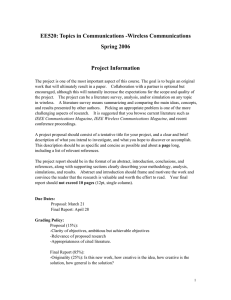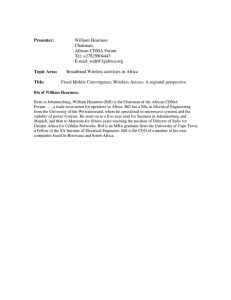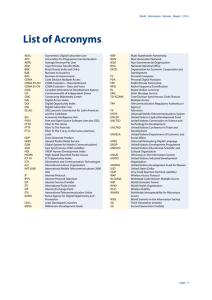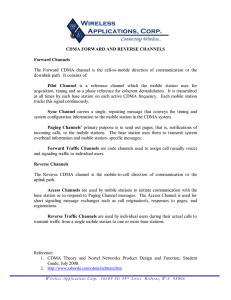Communication System for Distribution
advertisement
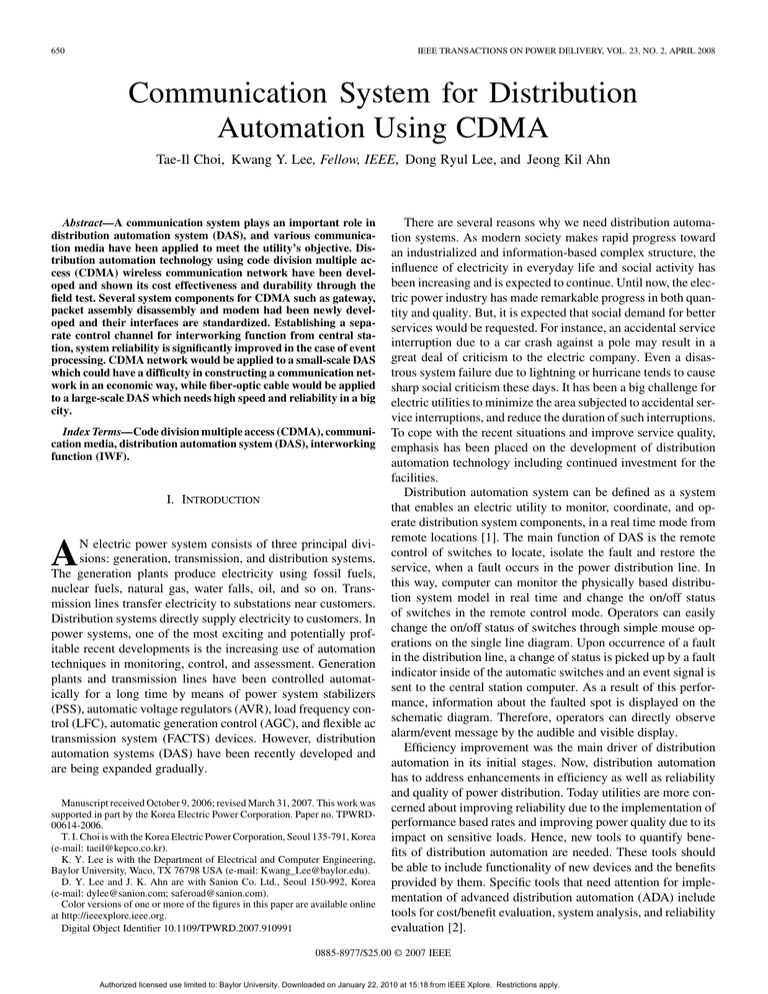
650 IEEE TRANSACTIONS ON POWER DELIVERY, VOL. 23, NO. 2, APRIL 2008 Communication System for Distribution Automation Using CDMA Tae-Il Choi, Kwang Y. Lee, Fellow, IEEE, Dong Ryul Lee, and Jeong Kil Ahn Abstract—A communication system plays an important role in distribution automation system (DAS), and various communication media have been applied to meet the utility’s objective. Distribution automation technology using code division multiple access (CDMA) wireless communication network have been developed and shown its cost effectiveness and durability through the field test. Several system components for CDMA such as gateway, packet assembly disassembly and modem had been newly developed and their interfaces are standardized. Establishing a separate control channel for interworking function from central station, system reliability is significantly improved in the case of event processing. CDMA network would be applied to a small-scale DAS which could have a difficulty in constructing a communication network in an economic way, while fiber-optic cable would be applied to a large-scale DAS which needs high speed and reliability in a big city. Index Terms—Code division multiple access (CDMA), communication media, distribution automation system (DAS), interworking function (IWF). I. INTRODUCTION N electric power system consists of three principal divisions: generation, transmission, and distribution systems. The generation plants produce electricity using fossil fuels, nuclear fuels, natural gas, water falls, oil, and so on. Transmission lines transfer electricity to substations near customers. Distribution systems directly supply electricity to customers. In power systems, one of the most exciting and potentially profitable recent developments is the increasing use of automation techniques in monitoring, control, and assessment. Generation plants and transmission lines have been controlled automatically for a long time by means of power system stabilizers (PSS), automatic voltage regulators (AVR), load frequency control (LFC), automatic generation control (AGC), and flexible ac transmission system (FACTS) devices. However, distribution automation systems (DAS) have been recently developed and are being expanded gradually. A Manuscript received October 9, 2006; revised March 31, 2007. This work was supported in part by the Korea Electric Power Corporation. Paper no. TPWRD00614-2006. T. I. Choi is with the Korea Electric Power Corporation, Seoul 135-791, Korea (e-mail: taeil@kepco.co.kr). K. Y. Lee is with the Department of Electrical and Computer Engineering, Baylor University, Waco, TX 76798 USA (e-mail: Kwang_Lee@baylor.edu). D. Y. Lee and J. K. Ahn are with Sanion Co. Ltd., Seoul 150-992, Korea (e-mail: dylee@sanion.com; saferoad@sanion.com). Color versions of one or more of the figures in this paper are available online at http://ieeexplore.ieee.org. Digital Object Identifier 10.1109/TPWRD.2007.910991 There are several reasons why we need distribution automation systems. As modern society makes rapid progress toward an industrialized and information-based complex structure, the influence of electricity in everyday life and social activity has been increasing and is expected to continue. Until now, the electric power industry has made remarkable progress in both quantity and quality. But, it is expected that social demand for better services would be requested. For instance, an accidental service interruption due to a car crash against a pole may result in a great deal of criticism to the electric company. Even a disastrous system failure due to lightning or hurricane tends to cause sharp social criticism these days. It has been a big challenge for electric utilities to minimize the area subjected to accidental service interruptions, and reduce the duration of such interruptions. To cope with the recent situations and improve service quality, emphasis has been placed on the development of distribution automation technology including continued investment for the facilities. Distribution automation system can be defined as a system that enables an electric utility to monitor, coordinate, and operate distribution system components, in a real time mode from remote locations [1]. The main function of DAS is the remote control of switches to locate, isolate the fault and restore the service, when a fault occurs in the power distribution line. In this way, computer can monitor the physically based distribution system model in real time and change the on/off status of switches in the remote control mode. Operators can easily change the on/off status of switches through simple mouse operations on the single line diagram. Upon occurrence of a fault in the distribution line, a change of status is picked up by a fault indicator inside of the automatic switches and an event signal is sent to the central station computer. As a result of this performance, information about the faulted spot is displayed on the schematic diagram. Therefore, operators can directly observe alarm/event message by the audible and visible display. Efficiency improvement was the main driver of distribution automation in its initial stages. Now, distribution automation has to address enhancements in efficiency as well as reliability and quality of power distribution. Today utilities are more concerned about improving reliability due to the implementation of performance based rates and improving power quality due to its impact on sensitive loads. Hence, new tools to quantify benefits of distribution automation are needed. These tools should be able to include functionality of new devices and the benefits provided by them. Specific tools that need attention for implementation of advanced distribution automation (ADA) include tools for cost/benefit evaluation, system analysis, and reliability evaluation [2]. 0885-8977/$25.00 © 2007 IEEE Authorized licensed use limited to: Baylor University. Downloaded on January 22, 2010 at 15:18 from IEEE Xplore. Restrictions apply. CHOI et al.: COMMUNICATION SYSTEM FOR DA USING CDMA Section II introduces the communication system for DAS, and various communication media which have been applied in the Korea Electric Power Corporation (KEPCO) are presented in Section III. A newly developed technology using CDMA and its successful results of field application are presented in Sections IV and V. Conclusions are drawn in Section VI. 651 TABLE I AUTOMATIC SWITCHES OF KEPCO (2005) II. COMMUNICATION SYSTEM FOR DAS A distribution automation system involves the integrated technologies of computer, communication, and electric devices. Electric utilities are expected to choose the communication media best suited for the characteristics of distribution facilities. Certain parts in the electric supply chain are naturally monopolies, because competition in other parts in the chain will take some time to be developed. Two-way communications could be used for distribution automation (DA) as the basis for additional applications by the utility and to offer additional, value-added services to customers [3]. Communication is very important to DA, because DA relies on the coordinate effort of various elements in the system. Many DA functions have been implemented by utilities throughout the world. These DA functions vary greatly in nature and so does their communication requirement. For example, feeder automation requires on-line data to be collected from tens of nodes located along the feeder. Different DA functions have so far almost always been implemented by using proprietary protocols. Thus, there has long been a great need for an open and integrated communication system capable of supporting all DA functions transparently. An important point to remember is that there is no one-communication technology that is right for every situation. Utilities must weigh the advantages and disadvantages of each to determine the right technology for their application. Two trends have been driving increased interest in distribution automation. 1) New intelligent electronic devices (IEDs) increase the available data at every distribution point. 2) Competition and development of new technology have decreased the costs of communicating with distribution equipment [4]. For power line communications (PLCs), the medium itself is owned by the distribution company. If telephone lines are used, the telephone company owns the medium. If radio technology is used, the ownership of communication medium (the airwaves) is not an issue, but their use is licensed. With increasing competition, business segregation and market uncertainties, electric utilities are unlikely to invest in major implementation of two-way communication system. Any long-term investment program incurs the risk of stranded assets and questions over ownership of hardware and data. This has limited the development of distribution automation system from reaching its full potential. Since the utilities themselves may be discouraged from investing in two-way communications, there may be greater possibilities for communication service providers such as telephone companies and wireless data communication services. Once the communication infrastructure is in place, a service provider could offer services such as distribution automation, automatic meter reading, and tariff management to various metering supply and distribution business [5], sharing the communication media such as telephone line, power line communication, trunked radio system, CATV network, etc. In contrast to the urban region, the outer suburban and rural areas present a vast geographical coverage with a low to sparse population density. Consequently, the demand for communications requires a slightly different approach due to the scale of economies [6]. DAS using commercial wireless network had been tried to make up for the defects of current communication methods, such as the lack of communication channels, low reliability, and difficulty of maintenance. This paper proposes DAS using a code division multiple access (CDMA) network that can operate with real-time function, bidirectional communication, and unsolicited messages from remote terminals. III. DAS IN KEPCO DAS has been in operation in KEPCO since the early 1980s. The history of DA has a close relationship with communication media. For the application of DAS, several communication options has been considered including radio frequency, telephone line, cellular phone, power line communication and fiber-optic cable. Many diverse benefits and applications have been suggested which depend upon efficient bidirectional communication between utility and distribution facilities. Several types of communication systems that have been used in KEPCO will be introduced. Table I shows the automatic switches that had been remotely controlled by DAS in KEPCO in 2005. A. Power Line Communication (PLC) The first DAS using PLC was installed in Kyong–Gi District Head Office in 1983. This system uses two-way data transmission over the 22.9 kV distribution network. At the substation, signals are injected onto the 22.9 kV distribution network and 42 automatic switches in two substations have been remotely controlled. However, the signal transmission speed was too slow compared with other communication media. In the case of frequent changes of distribution lines like underground construction and load transfer, the change of communication path often causes transmission failure, which is called “open circuit problem.” In other words, communication is lost with devices on the far side of an open circuit. This severely restricts the usefulness of PLC systems for applications involving reclosers, switches, sectionalizers, and outage detection. PLC systems also require that a signal transmitter/receiver be installed in all distribution substations that have a downstream PLC device. These are expensive and can have significant negative impact on the cost effectiveness of PLC solutions. Recently, a new technology using high frequencies is being developed and under field test, with the advantage that utilities do not need to invest for additional communication network. Authorized licensed use limited to: Baylor University. Downloaded on January 22, 2010 at 15:18 from IEEE Xplore. Restrictions apply. 652 IEEE TRANSACTIONS ON POWER DELIVERY, VOL. 23, NO. 2, APRIL 2008 B. Pair-Cable The prototype of Korean DAS (KODAS) was developed jointly by KEPCO Research Institute (KEPRI), Korea Electrotechnology Research Institute and six industrial partners from 1991 to 1993, as a national research project to enhance the competitiveness of domestic manufacturing industry. To evaluate in the real field, the prototype was installed in Kang–Dong Branch Office (B/O) in Seoul and in operation since 1994. As a communication media, 70 km-long pair cables were constructed and 125 automatic switches were installed to verify the remote control functions [7]. The other SCADA system using pair-cable has been in operation to study its performance and applicability to distribution line. The 122 automatic switches in 22 kV- underground distribution line have been remotely controlled in Choong–Boo B/O in downtown Seoul. Due to the low efficiency and poor reliability, pair cable has not been extended any more. C. Cable TV Network Cable TV networks have been constructed in the majority of large cities for the commercial broadcasting service since 1995. Therefore, DA using cable TV seemed to be practically possible and was expected to be economical. The 35 underground automatic switches had been operating to evaluate the reliability and economical efficiency in Yeong–Deung–Po B/O of downtown Seoul. Having difficulties in solving traffic problems in the network and low communication quality, all Cable TV networks for the field test were replaced with wireless network thereafter. D. Telephone Line The demonstration system using telephone line was installed in Ul–Reung B/O in 1997. Upon evaluation of the model system, it has been expanded to eight B/Os in rural area since 1998 and recently, about 19% of automatic switches have been controlled by telephone line. The advantage of telephone line is its wide service area all over the country. However, different ownership of the line and equipments often cause the delay of service restoration. Some intermittent communication errors still need to be improved continuously. These days, telephone lines are used less because of the costs associated with installation of telephone lines and dielectric isolation equipment, and also due to the monthly cost. The cost for installation of telephone lines is increasing with the remoteness of the location. E. Wireless Data Communication Wireless solutions have shown the greatest potential for automating distribution networks because they communicate virtually anywhere at a very low cost. A few private wireless data service companies began their commercial service in Korea since 1997. A demonstration system using a private wireless network was developed and installed in Gyong–Gi B/O to test the feasibility of data communication. Upon evaluation of the model system, DA using wireless data service has been expanded in their possible service areas. However, the service area of wireless data communication network is restricted to some big cities for their commercial use, and data communication response had been delayed during peak time intervals like an opening time of the stock exchange market. To solve this problem, a research project was planned to use CDMA which has a wide service area covering the whole country. After evaluation of the field test of Po-Hang B/O, the wireless network using CDMA was proven to be reliable and economic compared with other communication media. About 12% of automatic switches have been operating using wireless data communication, and DA using CDMA is going to be expanded in rural area instead of a trunked radio system (TRS) and telephone line. F. Trunked Radio System (TRS) Like other utilities, KEPCO has its own radio system network that was used for voice data communication in the past. Recently, data communication technology using digital TRS instruments was developed and the demonstration system was installed in Gu-Ri B/O with 15 switches to test its applicability for DA in 1999. The result of the field test showed that the communication quality was satisfactory for DA during the test period. However, some communication errors occurred when the voice and information data were concentrated during some special events like a service restoration process after a fault. In removing the shadow areas of radio wave caused by a restricted service area, not a small investment is required continuously for the establishment of TRS communication station and equipments. About 12% of automatic switches have been remotely controlled using TRS. G. Fiber-Optic Cable Fiber-optic cable is a very technically attractive solution, offering relatively unlimited bandwidth. Its dielectric and EMI/RFI noise immunity characteristics make it an ideal fit in the high-voltage operating environment. While fiber optic solutions are expensive, they offer two large benefits: first it allows utilities to bring back large amount of data on a frequent basis. Second, it can provide true, real-time communications. These benefits make fiber optic communications an attractive alternative if getting large amounts of data on a real time basis is critical and the location is not extremely remote. KEPCO itself possesses a huge backbone network covering the whole country with OPGW (composite ground wire with optical fiber). Large-scale DAS in urban area needs high reliability and high-speed because it needs to process a large amount of data in a short time compared with small-scale DAS in rural area with more dispersed facilities. About 57% of automatic switches in large cities have been remotely controlled, showing the best reliability and communication speed among all other communication media. IV. DAS USING CDMA To resolve the problems of the above-mentioned communication systems, such as the installation cost of telephone lines, radio wave shadow areas of TRS and restricted service area of private wireless data communication, a research project to develop the DA using CDMA was planned in 2002. Utilizing an existing public cellular network allows a utility to forgo upfront infrastructure as well as most of the on-going maintenance costs. These cost savings must be weighed against the fact that the network is not captive to the utility. With special Authorized licensed use limited to: Baylor University. Downloaded on January 22, 2010 at 15:18 from IEEE Xplore. Restrictions apply. CHOI et al.: COMMUNICATION SYSTEM FOR DA USING CDMA 653 Fig. 1. Configuration of CDMA system for distribution automation. security features, the security risk of using a public network is becoming negligible. Because the network is already built, cellular carriers have a key advantage in providing telemetry solutions, as it can be offered at a very low incremental cost. The fundamental technology of CDMA communication is the spread spectrum. Spread-spectrum transmission takes the input data and spreads it over predefined frequencies. The receiver must understand the pattern and de-spread the signal before data can be interpreted. As the CDMA technology can use the same frequency band in the whole service area, the efficiency of frequency utilization is superior to other methods. Using different code for each communication, it provides a great advantage with high quality and security characteristics in wireless communication. Adding above advantages to the widest service area covering the whole country, reliability of communication system for distribution facilities which are dispersed all over the country can be improved, proving the applicability of the wireless mobile communication network to DAS. Fig. 1 shows the configuration of CDMA communication system for DA. The gateway is linked to the central station of DAS which is installed in a Branch Office. The wireless packet assembly disassembly (PAD) is installed in the feeder remote terminal unit (FRTU) of a distribution automation switch. The CDMA network performs wireless data communication between central station and FRTU. Fig. 2 shows the data communication sequence of CDMA system for DA. The data request from central station is processed by modem to modem communication, and the unsolicited message transmission from many remote terminal units is processed by interworking function (IWF) with high reliability for wireless data communication. When the central station orders to read the status of switches, CDMA PAD transmits the command signal from CDMA gateway to FRTU which is connected to automatic switch and FRTU sends the status information to central station through the CDMA wireless network. Data transmission through the CDMA gateway is accomplished between CDMA PAD and CDMA modem that is linked to FRTU. Especially, when an unexpected event occurs, a different signal flow for unsolicited message is developed for the immediate report to the central station. When the data that is not linked to CDMA gateway are received from remote Fig. 2. Operation sequence of CDMA system for DA. terminals, CDMA PAD makes a connection with IWF and transmits the data through IWF to CDMA gateway. For a supplementary way, Internet-link can be constructed between IWF and CDMA gateway, transmitting the data between IWF and central station with a high transmission speed. In the case of an event, the orders from central station to read the status of FRTU are processed by directly communicating with IWF instead of connecting to CDMA modem. Once the communication path is constructed using IWF, a priority is given for a faster data processing and more flexible data communication within the same wireless communication network. CDMA Gateway supervises the whole communication system to confirm the system status through the CDMA PAD. CDMA PAD periodically transmits the polling signal to watch the signal power of CDMA modems, securing the communication quality. Since the CDMA is a public communication network, anyone can set up an arbitrary call to the CDMA PAD or the CDMA gateway. Hence, it is essential to encrypt data, which are transmitted between the CDMA gateway and the CDMA PAD. For the security of call set-up as well as data transmission, data encryption standards (DES) algorithm is installed at both the CDMA gateway and the CDMA PAD. DES encrypts and decrypts data in 64-bit blocks, using a 64-bit key. The gateway for CDMA transforms the protocol between DAS central station and CDMA wireless network. Fig. 3 shows the prototype of the gateway and PAD for CDMA that have been installed and in operation in Po-hang B/O for a field test. The gateway shows various kinds of information such as the trial and success number of communication, signal power for a quality analysis, the cumulative connection time, and the final result of communication using CDMA modem. A PAD for CDMA is installed inside the FRTU of each automatic switch. Using CDMA wireless network, the CDMA PAD transmits data between FRTU and central station through the gateway. The DNP3.0 protocol is used for the standard communication protocol [8]. The PAD for CDMA is physically interfacing with FRTU using RS 232C and includes RF modem. The CDMA PAD Authorized licensed use limited to: Baylor University. Downloaded on January 22, 2010 at 15:18 from IEEE Xplore. Restrictions apply. 654 IEEE TRANSACTIONS ON POWER DELIVERY, VOL. 23, NO. 2, APRIL 2008 TABLE III COMMUNICATION MEDIA OF AUTOMATIC SWITCHES TABLE IV COMPARISON OF TEST RESULTS Fig. 3. Gateway and PAD for CDMA. TABLE II DISTRIBUTION EQUIPMENT OF PO-HANG B/O controls its modem, analyzes the DNP protocol for DAS, performs Packet service, and controls the communication flow. Three kinds of communication ports are established in the PAD: console port, FRTU interface port, and RF modem interface port. The console port sets up PAD functions, monitors the communication frame, and observes the communication status, without a separate program when it is linked to the central station. Data of a PAD can be modified and verified through the console-port. The CDMA PAD supports two channels for network communication: modem to modem and IWF point-to-point protocol (PPP) connection. The signals in the physical interface between FRTU and the voltage source need to be electrically insulated to prevent the inflow of a surge. V. FIELD APPLICATION To evaluate the cost effectiveness and performance of CDMA mobile network in the real field, the prototype CDMA communication system for DA has been operating in Po-Hang B/O since 2002. The CDMA communications utilize the bandwidth for data communications on the existing cellular network. This “nonvoice” channel has an abundance of excess capacity from the major cellular carriers. Data can be sent bidirectionally; this allows the user to issue commands and request reports, as well as the field device to be able to initiate an alarm notification. The biggest downside of control channel is the small size of the data packets. The CDMA channels are the least costly of all solutions when a user wants a small amount of data sent infrequently. It is a great fit for reporting alarms and simple monitoring and control. CDMA applications are best suited for capacitor banks, reclosers, line switches, fault locators, load management, outage detection and voltage regulators. Table II shows the distribution equipments of Po-Hang B/O and 66 automatic switches among total 660 switches have been remotely controlled. D/L is the number of distribution lines to supply electricity to customers and concrete poles are used to support the distribution line. Table III shows the communication media which have been used for DA, namely, telephone line, TRS and CDMA. The 18 switches among 66 switches were controlled to verify the performance of CDMA wireless network and compared with other communication media. Three different methods are compared during the test period to evaluate the performance and cost effectiveness. Telephone line proved to be stable, but showed difficulties in maintenance because of its complex line configuration and the repair service were often delayed when urgent events occurred. Moreover, in the case of long line construction for isolated switches, rental charge increases and communication quality becomes poor. TRS has no rental charge and can be easily constructed because it is owned by KEPCO itself. However, it is not easy to get a license for the use of particular frequencies from the government. Also, there exist a lot of shadow areas for radio wave and not a small investment is required to improve the communication quality. On the contrary, CDMA wireless network is easy to install because of its nationwide service area. A reasonable service charge can be suggested compared with other communication media, sharing the wireless network with other commercial applications like cellular phone. DA using CDMA is a newly developed technology and proven to be superior to other communication media in cost effectiveness and performance during the test period. As CDMA network extends its applications, its communication quality is expected to be improved and the service charge to be lowered and competitive. Table IV shows the comparison of test results for three different communication media. CDMA wireless network shows the best communication performance of the three communication media. By using CDMA wireless network with IWF, communication quality can be greatly improved and the response time cannot be delayed any more during the peak time. The rate of success was 99.6%, showing that the CDMA network can be satisfactorily applied to real system. Until now, CDMA wireless network has been successfully operating without any serious troubles, proving to be persistent in severe weather conditions, even during a hurricane. Through the field test period, the stability for each system components such as gateway, PAD, and CDMA modem has been tested. For the default test, system performance has been ensured by trouble shooting and analysis during the operation. Analyzing the structure and contents has efficiently regulated the interface between communication equipments. There are Authorized licensed use limited to: Baylor University. Downloaded on January 22, 2010 at 15:18 from IEEE Xplore. Restrictions apply. CHOI et al.: COMMUNICATION SYSTEM FOR DA USING CDMA various types in remote terminals and each manufacturer has its own formation to realize the DA function. Therefore, when communication errors occurred in the network, various ways to solve the problems had to be accessed and the result was not satisfactory. During this research, the standardized way of interface had been suggested, which then is proven to be widely applied as a standard. With so many communication options available, potential users must thoroughly understand their needs before choosing a solution for their automation projects. In other words, there is no “right” solution, but rather solutions that are right for certain applications. The scale of distribution automation system can be adjusted according to the regional characteristics. A large-scale system in urban area is focused on high reliability and high-speed performance for the switching operations. On the contrary, a small-scale system in rural area is focused on the low cost and downsizing structure for simple remote operation of switches. From the point of view on reliability and economic efficiency, fiber-optic cable would be chosen for urban area, while wireless and CDMA would be chosen in suburban or rural area with more dispersed facilities [9]. 655 REFERENCES [1] D. Bassett, K. Clinard, J. Grainger, S. Purucker, and D. Ward, “Tutorial course: distribution automation,” IEEE Tutorial Publ. 88EH0280-8PWR, 1988. [2] A. Pahwa, “Planning and analysis tools to evaluate distribution automation implementation and benefits,” in Proc. IEEE Power Eng. Soc. General Meeting, Jun. 12–16, 2005, pp. 2853–2854. [3] P. Adrian, J. Newbury, and S. Gargan, “Two-way communications systems in the electricity supply industry,” IEEE Trans. Power Del., vol. 13, no. 1, pp. 53–58, Jan. 1998. [4] S. Schoenherr, “Wireless technologies for distribution automation,” in Proc. IEEE Power Eng. Soc. Transmission Distribution Conf. Expo., Sep. 7–12, 2003, vol. 1, pp. 375–378. [5] P. H. His and S. L. Chen, “Distribution automation communication infrastructure,” IEEE Trans. Power Del., vol. 13, no. 3, pp. 728–734, Jul. 1998. [6] T. Dhar and T. Tang, “Present and future communication technologies for distribution automation in rural Queensland, Australia,” in Proc. EMPD Int. Conf. Energy Management Power Delivery, Mar. 3–5, 1998, vol. 2, pp. 650–655. [7] S. M. Park, B. N. Ha, and T. I. Choi, “Feeder automation using pair Cable, CATV network and telemetering using LV power line,” in Proc. DA-DSM ASIA, Conf. Papers, Sep. 17, 1996, vol. 5, p. 5-255-262. [8] DNP Users Group, “Distributed network protocol,” 2005 [Online]. Available: http://www.dnp.org. [9] T. I. Choi, I. S. Koh, B. H. Kim, W. S. Song, and W. S. Jang, “PC-based remote control and fault location system for distribution line,” in Proc. IEEE Power Eng. Soc. Winter Meeting, Jan.31–Feb. 4, 1999, vol. 2, pp. 1085–1090. VI. CONCLUSION Distribution automation technology using CDMA wireless communication network, which has the widest service area all over the country, has been developed and shown its cost effectiveness and durability through the field test. Several system components for CDMA such as gateway, PAD and modem have been newly developed and their interfaces are standardized. Demonstrating the superior reliability compared with other communication media, CDMA network for DA is expected to replace existing communication media for DAS. As the commercial network is used, maintenance for the communication network is not necessary. Like other wireless network, CDMA terminals can be installed inside the control box of automatic switch at any place in distribution line and easily moved at any time. Establishing a separate control channel for IWF from central station, system reliability is significantly improved in the case of event processing. The CDMA network would be applied to a small-scale DAS which could have a difficulty in constructing a communication network in an economic way, while fiber-optic cable would be applied to a large-scale DAS which needs high speed and reliability in a big city. Frequent communication errors owing to the lack of communication channels can be resolved by using CDMA network without establishing an additional communication channel. A region that requires repeated maintenance and transfer is more suitable for CDMA network utilizing the unsolicited message from remote terminals. ACKNOWLEDGMENT The authors would like to thank the members who had participated in this research project for their support and advice. Tae-Il Choi received the B.S. degree in electrical engineering from Hanyang University, Seoul, Korea, in 1982 and the M.S. degree in electrical engineering from Pennsylvania State University, University Park, in 1993, where he is currently pursuing the Ph.D. degree in electrical engineering. Since 1982, he has been an Engineer with the Korea Electric Power Corporation, Seoul, and Section Chief in the distribution automation department since 1991. His research interests include distribution automation, artificial intelligence, and distributed generation. Kwang Y. Lee (F’01) received the B.S. degree in electrical engineering from Seoul National University, Seoul, Korea, in 1964, the M.S. degree in electrical engineering from North Dakota State University, Fargo, in 1968, and the Ph.D. degree in system science from Michigan State University, East Lansing, in 1971. He has been with Michigan State University, East Lansing; Oregon State University, Corvallis; University of Houston, Houston, TX; and the Pennsylvania State University, University Park, where he was a Professor of Electrical Engineering and Director of the Power Systems Control Laboratory. Currently, he is Professor and Chair of the Department of Electrical and Computer Engineering, Baylor University, Waco, TX. His interests include power system control, operation, planning, and intelligent system applications to power systems. Dr. Lee is an Associate Editor of the IEEE TRANSACTIONS ON NEURAL NETWORKS and Editor of the IEEE TRANSACTIONS ON ENERGY CONVERSION. He is also a registered Professional Engineer. Authorized licensed use limited to: Baylor University. Downloaded on January 22, 2010 at 15:18 from IEEE Xplore. Restrictions apply. 656 IEEE TRANSACTIONS ON POWER DELIVERY, VOL. 23, NO. 2, APRIL 2008 Dong Ryul Lee received the B.S. degree in control and instrumentation engineering from Seoul National University, Seoul, Korea, in 1985 and the M.S. degree in control and instrumentation engineering from Seoul National University in 1989. He was a Chief Engineer with Samsung Electronics until 1992 and a CTO with Fine Digital Co. until 1997. Currently, he is a CEO with SANION Co., Seoul. His interests include power system control, operation, planning, and intelligent system applications to power systems. Jeong Kil Ahn received the B.S. and M.S. degrees in electrical engineering from Hankuk Aviation University, Seoul, Korea, in 1982 and 1993, respectively. From 1993 to 1997, he was an Engineer with KumKyoung Industrial Systems and was Chief in the Telecommunication Department with Kisan Telecom in 1998. Currently, he is a General Manager with Sanion Co., Seoul. His research interests include distribution automation and mobile telecommunications, such as OFDM, WLAN, and Power IT. Authorized licensed use limited to: Baylor University. Downloaded on January 22, 2010 at 15:18 from IEEE Xplore. Restrictions apply.
